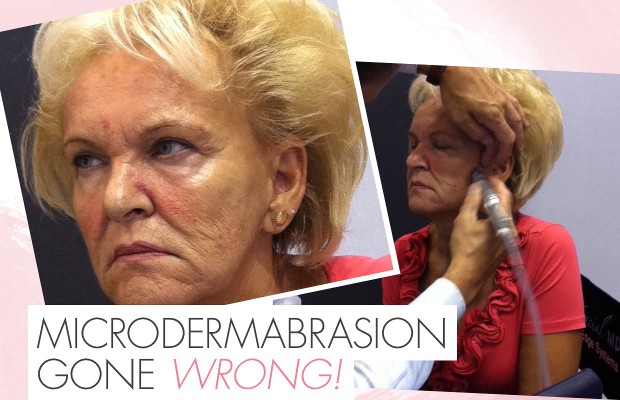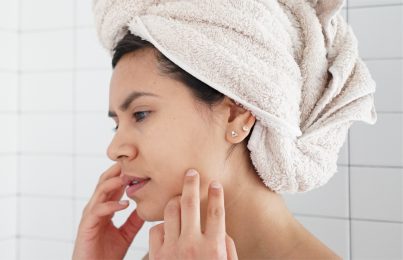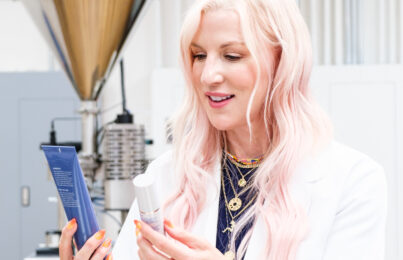I recently attended Paris Beauty Week, a trade show dedicated to the newest innovations in skin care. As I was walking through the aisles and aisles of exhibitors, I noticed a man just starting to perform a treatment to a woman’s skin using some sort of wand. Since I attended the show to see new developments, I went over to see what kind of treatment he was doing to her skin. He had a microdermabrasion machine, but instead of just exfoliating the skin, which is traditionally what microdermabrasion does, it also delivered water-based hydration (via the machine) to the skin at the same time. While I don’t believe microdermabrasion is for everyone (especially those with thin, sensitive, and red skins), it seemed like a cool new spin on this procedure.
The first red flag for me was his patient/client. I’m not sure if she was an attendee that just walked past his booth, or if she was his mother, but in observing her skin I found it to be extremely thin and sun-damaged. For many French women, wearing daily sunscreen was not, and is still not a part of a skin care regimen, and this appeared to be the case with her. I would guess from her skin that she is a smoker too.
He started performing the treatment on her cheeks, and immediately what happened was her skin got incredibly red. When you undergo microdermabrasion, a closed vacuum device gently sprays aluminum oxide crystals through a tube, into a hand piece, and onto your skin. The machine mixes the gentle abrasion particles with suction to remove the surface dry, damaged outer layers of your skin. The problem with microdermabrasion is that, in the case of this woman, her skin was extremely thin, and because of her sun damage and age, her capillaries were already fragile. So when this man proceeded to give suction on her skin, it pulled and tugged, and immediately dilated and even broke some of her blood vessels. I watched this go on for only about two minutes, and I simply had to walk away. I was truly sick to my stomach. I couldn’t believe what I was seeing, because it was so obvious to me, as a licensed esthetician, that he was completely damaging her skin.
Any time you have suction on the skin to the point of breaking blood vessels, they may or may not visibly ever repair themselves. For example, years ago when I was doing triathlons, I removed my goggles off of my face, and the suction pulled so hard that it broke a capillary under my eye, that I still have to this day. (I could have it removed, but just haven’t gotten around to it.) At the time, I was 35, where my skin was in good, healthy condition and blood vessels and capillaries could easily repair themselves, but it never did. So to see a man perform this treatment to the skin of a woman who I would imagine is well into her 70s, he very well may have created permanent damage to her skin. While I didn’t stay around to see it continue because I couldn’t bear to watch it anymore, some of the areas may have resulted in bruising 10-15 minutes after the treatment, almost like giving the skin a hickey. I highly doubt that this was what the woman was looking to get out of the treatment.
So in my professional opinion, here is where this man went wrong.
Never have microdermabrasion while sitting up.
For starters, this man should have known that when you are sitting up, especially for a woman such as her and the condition of her skin, the skin sags down, making it extremely difficult to manipulate the wand effectively over the skin. For this type of treatment to be safely performed, he should have had her lying down to have better control of her skin.
Never perform microdermabrasion on thin skin.
As most skin care professionals should know, when a woman is in her late 60s, 70s, and 80s, their skin is already thin – so to perform an aggressive treatment such as this will only make the skin thinner, regardless of whether or not it gets red. This is the last thing that should be done. For her, if she were my client, I wouldn’t be focusing on aggressive exfoliating treatments, but rather skin-tightening treatments along with the use of ingredients such as peptides that help to encourage firming of the skin. Also, I would perform deeply moisturizing treatments to plump up her lines and wrinkles.
The skin should always be pulled tight.
As I mentioned above, you always want to have this treatment while lying down – which was his first mistake. When having microdermabrasion, the professional should always pull the skin taut before applying the wand to the skin in an effort to have the skin not get sucked up into the vacuum, therefore dilating and breaking blood vessels. Because she was sitting upright and he did not pull her skin tight, the suction was greater on her skin than it should have been. This was part of why her skin reacted so negatively.
Only trust your skin to a licensed professional.
Because I didn’t stick around to continue to watch this horrendous experience, I didn’t get to find out who this man was. I can only assume that he was a sales person, working for this company, and was not a licensed professional that knew anything about skin. I’m sure he knows the machine inside and out, but skin can be very complex and this man didn’t seem to realize it. I’m a firm believer that when it comes to having professional treatments, and even when consulting with someone to recommend products, someone who has years of experience and truly understands how the skin functions will give the best care and results for your skin. This is why I often frown at skin care product salespeople that have not have any training to understand the complexities of the skin. This is just my personal belief, and everyone is entitled to their own. This is simply what my experience tells me to be true.
Read: Cosmetic Dermatologist or Esthetician: What is the Best Approach for Your Skin?
That being said, I think about this woman and wonder what the expression on her face was when the treatment was finished, and she discovered severe redness, as well as damaged and broken blood vessels all over her face. I feel so sorry for this woman, because I don’t believe she knew what she was getting into.
Celebrity Esthetician & Skincare Expert
As an esthetician trained in cosmetic chemistry, Renée Rouleau has spent 30 years researching skin, educating her audience, and building an award-winning line of products. Her hands-on experience as an esthetician and trusted skin care expert has created a real-world solution — products that are formulated for nine different types of skin so your face will get exactly what it needs to look and feel its best. Trusted by celebrities, editors, bloggers, and skincare obsessives around the globe, her vast real-world knowledge and constant research are why Marie Claire calls her “the most passionate skin practitioner we know.”




Comments:
I just had microdermabrasion, one side of my face looks like a little road rash is this normal?
Posted By: Tammy Quilling |
No, this shouldn’t happen. I would reach out to the provider of your treatment.
Posted By: Renée Rouleau |
These can be effective for the right types of skin.
Posted By: Renée Rouleau |
My son it having a heavy chemical peel. When told that “sun exposure should be avoided”, does that mean sunlight one would get from staying in the shade or just direct sun rays?
Posted By: Jasmine |
They typically mean direct sun exposure, like avoiding getting a suntan or sunburn. However, all forms of daylight (even in shade) are still damaging to the skin. At the very least, make sure he doesn’t go to the lake, pool or beach for at least 10 days after a chemical peel and have him wear sunscreen daily like this one. https://www.reneerouleau.com/products/daily-protection-spf-30
Posted By: Renée Rouleau |
How do you treat hickey, bruised skin from microderm?
Posted By: katie |
Time should heal those but if not, then some laser treatments will help.
Posted By: Renée Rouleau |